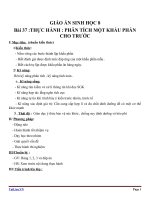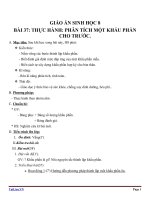hướng dẫn cpanel và hướng dẫn nhận được nhiều nhất từ cpanel với điều này dễ làm theo hướng dẫn
Bạn đang xem bản rút gọn của tài liệu. Xem và tải ngay bản đầy đủ của tài liệu tại đây (6.56 MB, 208 trang )
cPanel: User Guide and Tutorial
Get the most from cPanel with this
easy-to-follow guide
Aric Pedersen
BIRMINGHAM - MUMBAI
cPanel: User Guide and Tutorial
Get the most from cPanel with this easy-to-follow guide
Copyright © 2006 Packt Publishing
All rights reserved. No part of this book may be reproduced, stored in a retrieval system, or
transmitted in any form or by any means, without the prior written permission of the publisher,
except in the case of brief quotations embedded in critical articles or reviews.
Every effort has been made in the preparation of this book to ensure the accuracy of the
information presented. However, the information contained in this book is sold without warranty,
either express or implied. Neither the author, Packt Publishing, nor its dealers or distributors will
be held liable for any damages caused or alleged to be caused directly or indirectly by this book.
Packt Publishing has endeavored to provide trademark information about all the companies and
products mentioned in this book by the appropriate use of capitals. However, Packt Publishing
cannot guarantee the accuracy of this information.
First published: March 2006
Production Reference: 1030306
Published by Packt Publishing Ltd.
32 Lincoln Road
Olton
Birmingham, B27 6PA, UK.
ISBN 1-904811-92-2
www.packtpub.com
Cover Design by www.visionwt.com
Credits
Author
Aric Pedersen
Reviewer
Tad Boomer
Technical Editor
Rushabh Sanghavi
Editorial Manager
Dipali Chittar
Development Editor
David Barnes
Indexer
Ashutosh Pande
Proofreader
Chris Smith
Production Coordinator
Manjiri Nadkarni
Cover Designer
Helen Wood
About the Author
Aric Pedersen has been using cPanel on a daily basis for over six years both as an end user for
his own websites and as a systems administrator. He currently works as a systems administrator
for several hosting companies and also for Netenberg.com, the creators of Fantastico Deluxe (a
popular script auto-installer for cPanel). Aric has been providing companies and end users with
web hosting and related documentation for several years.
Though my name is on the front of this book, this project was not completed alone and I
would like to take the time to thank a few people.
To my mother and Allen: My sincerest thanks for your support, now and always. I love
both of you.
To Tony: Thanks for making me realize how much this thing really needed to get turned
into a book!
To Manny: Thanks for taking that first chance and hiring me.
To John/Jack, Esq. III: People like you fight to keep America free so people like me can
write stuff like this even if people like you don’t understand a word of it! ☺ I owe you.
To my publisher: This book wouldn’t be half as good as it is without your invaluable
assistance.
I would also like to thank the hundreds of people who helped me when I was first learning
how cPanel worked. This book is my attempt to give back to the community.
Finally, thanks to YOU for purchasing this book!
Table of Contents
Preface 1
Chapter 1: Introduction to cPanel Hosting 9
Webmaster, Meet cPanel… 9
What Tools Will You Need? 9
Finding cPanel Web Hosting 10
Types of Web Hosting 10
Windows versus Linux Hosting 11
Hunting for Hosting 11
The Quest for Features 12
Questions to Ask Hosting Companies 13
How's the Company's Support? 14
What Special Features does the Company Offer? 14
What are the Company's Hosting Policies? 15
Summary 16
Chapter 2: Getting Started with cPanel 17
Logging into cPanel 17
Logging into cPanel from Behind a Firewall 18
The Main cPanel Interface 19
General Account Information 20
Resource Usage 21
Mail and FTP Information 21
General Server Information 22
Programming Language and Database Information 23
cPanel Information 24
Summary 24
Chapter 3: FTP and cPanel's File Manager 25
FTP Basics 26
General FTP Tools 26
Configuring your FTP Client for use with your Main FTP Account 26
Table of Contents
Creating and Managing FTP Accounts in cPanel 28
Creating a New FTP Account in cPanel 28
Monitoring your FTP Usage in cPanel 30
Anonymous FTP Access 30
cPanel FTP Session Control 31
Other Types of FTP Connections 31
Secure FTP 32
FXP Transfers 32
cPanel's File Manager 33
A Few Words about File Permissions 34
Summary 36
Chapter 4: Working with Mail 37
Why Manage your Own E-mail Accounts? 37
Common E-mail Terms 38
Accessing cPanel's E-mail Features 39
Managing POP3 and IMAP E-mail Accounts 39
Creating an E-mail Account 40
Configuring your E-mail Client to Use your New Address 40
Changing Advanced E-mail Options and Monitoring your E-mail Account 41
Web Mail 42
Accessing Web Mail 42
E-mail Forwarders (Aliases) 44
E-mail Domain Forwarding 45
Mailing Lists 45
Dealing with Unsolicited E-mail (SPAM) 46
SpamAssassin 46
SpamBox 48
E-mail Filtering 49
BoxTrapper 50
Virus Scanning using ClamAV 51
Default (Catch All) E-mail Address 52
E-mail Auto-Responders 52
Advanced E-mail Tools 54
Summary 54
ii
Table of Contents
Chapter 5: Working with Databases 55
Database 101 55
Working with Databases in cPanel 56
Creating a Database 57
Creating a Database User 57
Adding a User to a Database 57
Removing or Repairing a Database 57
phpMyAdmin and phpPgAdmin 58
phpMyAdmin 58
phpPgAdmin 61
Summary 63
Chapter 6: Controlling Access to and Organizing Your Data 65
Changing your cPanel Password 65
Subdomains 67
Redirects 69
Hotlink Protection: Stop People from Stealing Content 69
Password-Protect Directories 71
Leech Protect: Keep Users from Giving Away Access to your Site 72
Index Manager 73
IP Deny Manager 74
Custom Web Error Messages 75
Summary 76
Chapter 7: Keeping an Eye on Account Activity 77
Web Statistics: What's Going On? 77
Raw (Apache) Web Logs 77
Raw Log Control 78
Web Stats to the Rescue! 79
Analog 80
Awstats 81
Webalizer 82
Urchin 83
Statistics Configuration 83
Other Related Tools 84
Last Visitors 84
Bandwidth 84
iii
Table of Contents
Error Log 86
Disk Usage 86
Summary 87
Chapter 8: Backing up and Restoring Data 89
Backups and their Importance 89
Home Directory Backup 91
Database Backup 91
E-mail Aliases (Forwarders) and Filters Backup 91
Full Backups 92
Automated Unattended Backups 93
Restoring Backups 93
Summary 94
Chapter 9: Working with Scripts 95
What are Web Scripts? 95
The Scripts cPanel Offers for Installation 96
The Scripts Library 96
Advanced Guestbook 98
b2Evolution 99
Coppermine 100
cPSupport 101
e107 101
Geeklog 103
Invision Power Board 104
Mambo Open Source 105
Nucleus 106
osCommerce 107
PHP-Nuke 108
phpBB 109
phpWiki 110
PostNuke 111
WordPress 112
Xoops 113
Chat Rooms 114
Entropychat 114
Melange 114
phpMyChat 115
Shopping Carts 115
AgoraCart 116
Interchange 116
iv
Table of Contents
CGI Center 117
CGIWrapper 117
Random HTML 117
Simple Guestbook 118
Advanced Guestbook 118
Counter 118
Clock 118
Countdown 118
CGI E-mail 118
FormMail Clone 118
Entropy Search 119
Entropy Banner 119
Third-Party Add-ons 119
Finding Other Web Scripts 119
Advice on Working with Scripts 119
Summary 120
Chapter 10: Advanced cPanel Features 121
Welcome to cPanel 102 121
FrontPage Extensions 121
Add-on Domains 122
Parked Domains 124
Cron Jobs 124
SSH/Telnet 126
MIME Types 126
Apache Handlers 127
OpenPGP Keys 127
SSL Management 128
Network Tools 133
Domain Lookup Tool 133
Traceroute Tool 134
cPanel Pro 134
Image Manager 134
Leech Protect 135
ClamAV 135
Submit a Support Request 135
Summary 136
v
Table of Contents
Chapter 11: Site and Account Security 137
Site Security and You 137
The Security Plan 138
What to do if the Worst Happens 140
Step One: Contact Your Web Host 140
Step Two: Restore and Verify All Data and Secure Site 141
Summary 142
Chapter 12: Third-Party Additions to cPanel 143
cPanel Themes: New Look, New Features 143
cPanel's Other Themes 143
Blue Lagoon 143
Monsoon 145
Xmail 146
X2 147
Third-Party Themes 148
7Dana 148
Ace 149
BlueCrush 150
CoolBreeze 151
CPANEL XP Evolution 152
cpSkins 153
iCandy 154
InteliSkin 155
Java 156
Radiance 157
RVSKIN 158
Simskins 160
Stainless Steel 161
Trix 162
Winterfall 163
XController 164
ZabrinskiPoint 165
Third-Party Add-ons 165
Fantastico: The Original Script Autoinstaller 166
Autoinstaller: More Scripts for cPanel's Script Library 167
OpenInstaller: Additional Script Library Scripts, for Free 168
MailScanner cPanel Front End: Kill E-mail Nuisances before they Reach
your In-Box 168
Exploring MailScanner Front End's Many Features 169
How does MailScanner Handle Mail? 171
vi
Table of Contents
Other Third-Party Add-ons 173
Summary 173
Chapter 13: Useful Tools and Links and the Final Curtain Call 175
FTP Clients 175
Additional cPanel Information 176
Basic Webmaster and Scripting Assistance 176
Domain, DNS, and Site Monitoring Tools 177
Password Storing Programs 178
Curtain Call 179
Appendix A: Glossary 181
vii
Preface
This book is designed to provide in-depth information for anyone who needs assistance with
cPanel web hosting software. If you've never managed your own website before you will be able
to confidently use the many features cPanel provides after reading this book. Even intermediate
and advanced users of cPanel will likely learn many tips and tricks that will enable them to work
both faster and smarter.
What This Book Covers
Chapter 1: Introduction to cPanel Hosting
Before diving into the many features, you will learn:
• What cPanel is and what it is used for
• What tools you will need to get started working with cPanel and your website
• How to locate a web host that offers cPanel and what to look for in a good host
Chapter 2: Getting Started with cPanel
Start learning a few things about cPanel:
• Access cPanel in several different ways
• Familiarize yourself with the main cPanel interface
• Learn about some of the features of your cPanel account
Chapter 3: FTP and cPanel's File Manager
In this chapter you will discover most of the methods that cPanel provides to enable you to
transfer files to and from your web hosting account:
• Discuss methods of uploading files to your hosting account
• Learn about the types of FTP clients available
• Learn how to work with FTP
• Accessing the main FTP account
• Creating FTP accounts and placing limits on those accounts
• Deleting FTP accounts
• Checking FTP quotas for accounts you create
Preface
• Managing Anonymous FTP access
• Monitoring FTP access and killing FTP sessions
• SFTP (Secure FTP)
• FXP (File Exchange Protocol)
• Navigating your site with the cPanel file manager
• Uploading files and downloading files, editing and managing files with the file manager
• WYSIWYG HTML editing via WYSIWYG Pro in the file manager
Chapter 4: Working with Mail
Dive into the many features cPanel offers for working with e-mail:
• Why you may want to manage your own e-mail accounts
• How to setup and manage POP3 and IMAP e-mail accounts
• How to create e-mail forwarders and forward all e-mail from one account to another
• Ways to combat spam and viruses using features available in cPanel
• How to work with web mail
• How to manage mailing lists
• The more advanced features cPanel provides for working with e-mail (changing MX
records, tracing mail, etc.)
Chapter 5: Working with Databases
In this chapter we will explore the wonderful world of databases:
• What databases are and what they are used for
• How to work with both MySQL and PostgreSQL databases in cPanel to handle
administrative tasks
• Creating databases
• Creating database users
• Adding users to databases
• Common connection settings for databases
• Deleting databases and users
• Checking for damage, repairing, and optimizing databases
• Basics of working with databases using phpMyAdmin or phpPgAdmin
• Backing up databases with phpMyAdmin or phpPgAdmin
2
Preface
Chapter 6: Controlling Access to and Organizing Your Data
In this chapter, you will learn how to manage access to and organize your site using numerous
cPanel tools:
• Change your main cPanel password
• Create and manage subdomains
• What redirects are and why you might use them
• Enable hotlink protection and learn how to use it
• Manage leech protection
• Password-protect directories
• Stop problem users from visiting your site with the IP deny manager
• Create custom error messages
Chapter 7: Keeping an Eye on Account Activity
cPanel offers a number of features designed to allow you to keep track of what is happening in
your account. In this chapter we will focus on:
• How to work with the various web statistics packages that cPanel offers
• How to disable and re-enable web statistics packages using the Stats Manager
• When and how to use your site's raw web logs
• How to keep track of the disk space your files are taking up
• How to use your cPanel error log to track down problems
Chapter 8: Backing up and Restoring Data
cPanel includes a number of tools that can help you get your site up and running again quickly in
the event of data loss:
• What backups are and why they are so important
• How to use cPanel to back up the data in your account
• Automated backup methods
• How to use cPanel to restore the data that you've backed up
• What to do if you do not have a backup and need to restore the data in your account
3
Preface
Chapter 9: Working with Scripts
Regardless of your level of expertise, there will probably come a time when you want to add
content or features to your website without spending days or weeks coding something or paying
someone to create the content for you. This is where pre-coded web scripts may come in handy. In
this chapter we will cover:
• What scripts are and what you might want to use them for
• What scripts cPanel offers for installation and how to install them
• Some important advice concerning working with scripts.
Chapter 10: Advanced cPanel Features
You've mastered the basics and are still hungry for more, so in this chapter, we will explore:
• How to enable and disable FrontPage Extensions and learn why you may or may not
need them
• Creating and managing Add-on and Parked Domains
• Creating Cron jobs and learning what they can be used for
• The basics of working with SSH/Telnet
• Editing MIME Types and learning what they are used for
• Adding Apache Handlers and learning their uses
• The cPanel interface for creating and storing OpenPGP Keys
• How to manage SSL certificates using cPanel
• The advanced network tools cPanel offers
• What cPanel Pro is and what new features it can provide
Chapter 11: Site and Account Security
You know how to use the features in your cPanel account and now it is time to learn how to
protect yourself and your account data. Specifically, we will cover the following:
• What hacking is and why you may be at risk
• What you can do to protect yourself and your site from attack
• What to do if your site is hacked
Chapter 12: Third-Party Additions to cPanel
This chapter will cover most common cPanel additions, and you will discover:
• Many popular cPanel themes and learn about what makes them unique
• A number of popular third-party add-ons for cPanel and learn how they work
4
Preface
Chapter 13: Useful Tools and Links and the Final Curtain Call
You've learned how to use the tools cPanel gives you. In this chapter you will find several great
links for tools you can use for:
• FTP clients
• More cPanel information
• Basic webmaster and scripting assistance
• Domain, DNS, and Site Monitoring tools
• Password-storing programs
The Changing Nature of cPanel
While the information in this book is as current as possible at the time of its publication (covering
cPanel 10.8.1), the features and functions of cPanel may be different from what is described in this
book. The primary reasons for this are:
• cPanel is constantly being updated and revised to add new features and fix bugs. New
features may be added or existing features extended or rearranged.
• Not all web hosts offer all features mentioned in this guide with all hosting plans. This is
particularly true of some of the third-party add-ons that will be discussed. If you have
questions about what features your web host offers, please contact them directly.
• Some web hosts may use a different default theme for cPanel than the one you see in this
book (XSkin). Please see Chapter 12 for some screenshots of other themes that your host
might offer.
Additional Assistance
If you find that you need additional information or assistance with cPanel there are several places
you can turn to for help.
The first place to go if you have any questions is your web hosting company. They should be able
to answer almost any question you have concerning cPanel or any web hosting plan features.
Please be sure to follow your web host's support procedures when asking for assistance.
cPanel Inc., the makers of cPanel also maintain a customer-to-customer general support forum
not This forum is designed as a main means of support for cPanel,
but is a good place to go if you have questions or concerns that your web host cannot answer.
Often you can find answers to commonly asked questions by searching the forum, so make sure
you try that before attempting to post a question.
cPanel Inc. also maintains some very basic (and typically very outdated) documentation. The
online version of this documentation can be found at
You may also be able to find this documentation as a link directly from the main screen of the
5
Preface
cPanel interface (depending on the theme your web host provides). A PDF version of this
documentation can be downloaded from
Note that
PDF files require a PDF reader such as the free Adobe Reader program, which you can obtain
from
Conventions
In this book, you will find a number of styles of text that distinguish between different kinds of
information. Here are some examples of these styles, and an explanation of their meaning.
There are three styles for code. Code words in text are shown as follows: "We can include other
contexts through the use of the
include directive."
A block of code will be set as follows:
<? header ("Location: ?>
<html>
<title>Page Title</title>
<head></head>
<body></body>
</html>
When we wish to draw your attention to a particular part of a code block, the relevant lines or
items will be made bold:
<? header ("Location: "); ?>
<html>
<title>Page Title</title>
<head></head>
<body></body>
</html>
New terms and important words are introduced in a bold-type font. Words that you see on the
screen, in menus or dialog boxes for example, appear in our text like this: "clicking the
Next
button moves you to the next screen".
Warnings or important notes appear in a box like this.
Tips and tricks appear like this.
Reader Feedback
Feedback from our readers is always welcome. Let us know what you think about this book, what
you liked or may have disliked. Reader feedback is important for us to develop titles that you
really get the most out of.
To send us general feedback, simply drop an e-mail to
, making sure to
mention the book title in the subject of your message.
6
Preface
If there is a book that you need and would like to see us publish, please send us a note in the
SUGGEST A TITLE form on www.packtpub.com or e-mail
If there is a topic that you have expertise in and you are interested in either writing or contributing
to a book, see our author guide on
www.packtpub.com/authors.
Customer Support
Now that you are the proud owner of a Packt book, we have a number of things to help you to get
the most from your purchase.
Errata
Although we have taken every care to ensure the accuracy of our contents, mistakes do happen. If
you find a mistake in one of our books—maybe a mistake in text or code—we would be grateful if
you would report this to us. By doing this you can save other readers from frustration, and help to
improve subsequent versions of this book. If you find any errata, report them by visiting
selecting your book, clicking on the Submit Errata link, and
entering the details of your errata. Once your errata have been verified, your submission will be
accepted and the errata added to the list of existing errata. The existing errata can be viewed by
selecting your title from
Questions
You can contact us at if you are having a problem with some aspect of
the book, and we will do our best to address it.
7
1
Introduction to cPanel Hosting
The cPanel web hosting software is an easy-to-use, feature-rich tool for managing your website.
But before we dive into all of cPanel's features, we need to have a basic idea about cPanel—What
is it used for, what tools will you need to get started working with cPanel, how to locate a web
host that offers cPanel, and what to look for in a good host.
So let's start by learning a little bit about what exactly is cPanel.
Webmaster, Meet cPanel…
Once you've decided that you want to create your own website, you have a lot of work ahead. You
need to design content and figure out how to upload it to your site. Then you need to attract people
to your site and manage any other features that your web host may offer such as e-mail, databases,
subdomains, site security, etc. If you have no previous experience with handling any of this, it can
be quite overwhelming.
cPanel is a web hosting control software that can be accessed using any modern web browser. It is
designed to make the complex task of managing your hosting account easy. With the aid of cPanel
and this book you should be able to get your new site up and running in no time.
What Tools Will You Need?
These are a few things which you will need before you start working with cPanel:
•
Private Internet Access: You need to be able to freely access the Internet from a
private location. For security reasons you should never try to access your cPanel
account or work on your website from a public location like a library, school, or job.
•
A modern web browser: cPanel works well in any recent web browser like Internet
Explorer 5.5+, Netscape 7+, Mozilla, Firefox, Safari, or Opera. If you are using an
older web browser you should upgrade if you want to use cPanel.
Introduction to cPanel Hosting
10
In addition, you may also want to make sure you have access to some of the following optional tools:
•
An HTML editor: Such programs make it easier to create or edit files that are part
of your website.
•
An FTP client: This sort of program is used to upload, download, and manage files
on your website. A client that supports
SFTP (Secure FTP) is a bonus.
•
More than one modern web browser: This can be handy to test your new website
to make sure it looks the same on a wide variety of browsers.
•
An e-mail program: If your hosting account includes e-mail, you will most likely
find managing e-mail easier if you use a dedicated e-mail program rather than
web-based e-mail programs.
You can find a list of commonly used tools and resources in Chapter 12.
Finding cPanel Web Hosting
If you don't already have a web host that offers cPanel, then the first order of business will be to
locate one. There are probably tens of thousands of web hosts that offer cPanel to their clients.
How do you go about finding the one that is right for you?
Types of Web Hosting
There are several different kinds of web hosting options, and it is important to understand the
difference between them before you begin looking for a host.
The most common type of web hosting (and generally the cheapest) is Shared Hosting. Shared
Hosting means that there are many websites hosted on a single web server. A web server is a
special computer that handles storing and displaying websites. For most people who are looking to
host a website for the first time or those who are concerned about the cost, shared hosting is the
best choice. Since many websites are served from a single machine, the costs are generally lower
than other hosting options. Costs vary from 0 to 40 USD per month on average.
However, shared hosting does have some drawbacks. The more sites a web server hosts, the more
likely it is that your website may react sluggishly, since there are many demands on the web
server. If you decide to purchase a shared web hosting account, you should ask your host what
kind of hardware they host accounts on. Faster machines with more RAM are preferable. For
example, a Dual Xeon CPU server with 2 GB of RAM will generally perform better than an old
single Celeron CPU server with 512 MB of RAM. Just as important as knowing the server
hardware, is getting a sense of how many shared hosting accounts your host will put on a server
before considering it full—the fewer, the better.
Chapter 1
The next type of web hosting is often referred to as Reseller Hosting. This is similar to shared
hosting, except that you are allowed to resell shared hosting accounts to others. Reseller hosting
allows you to start your own web hosting business. The average cost of a reseller hosting plan
tends to fall between 20 and 60 USD a month. For those people who want to start a web hosting
business but who do not have money for a VPS or dedicated server, reseller hosting is a good
choice. The drawback is that like shared hosting, there may be many reseller hosting accounts on a
server, each with many resold accounts. Knowing more about what kind of web server you will be
hosted on is important.
On servers that contain resellers, the actual number of shared hosting accounts may vary widely,
depending on how many accounts each reseller has.
Many hosts do not require that you actually
resell accounts if you buy a reseller plan. If so, then it is a good
step-up from standard shared
hosting since you can typically host many domains under a single reseller account with no extra
fees involved. In addition, you get more control over the domains you manage in a reseller plan.
Some hosts will also offer VPS/VDS hosting and perhaps even Dedicated Servers. VPS (Virtual
Private Server) and VDS (Virtual Dedicated Server) hosting are different names for the same type
of hosting accounts. Such accounts use special software to take a single physical web server and
divide it into two or more separate virtual web servers. Each virtual server acts as if it is a
completely separate machine. Each virtual machine gets a guaranteed amount of the physical
server resources including use of the CPU and disk space. VPS/VDS accounts have many of the
advantages of dedicated servers without the higher cost. A VPS/VDS account may cost from 30 to
120 USD a month on average.
If you purchase a dedicated server, you receive an entire web server with no other accounts
on it. Most of the time dedicated servers also permit you system administrator access (which
allows you complete control over the server). Dedicated servers on average cost between 100
and 500 USD a month.
Windows versus Linux Hosting
In addition to the variation in types of hosting you can buy, some web hosts may offer both Linux
and Windows operating system hosting. Some people who are new to web hosting may think that
if they run Windows at home on their computer that they need Windows hosting. This is not true.
Linux hosting plans typically cost less than Windows hosting plans due to the relative costs of the
operating systems (Linux is often free and Windows costs money). cPanel only runs on Linux at
this time, though Windows and Mac OS X versions are being prepared.
Hunting for Hosting
Now that you understand the difference between the various sorts of hosting you can purchase,
you're ready to start looking for a host for your website. There are many different places you can
look for information about hosting companies and hosting plans. Of course, you can visit Google
(
and search for cPanel hosting to find some web hosts, but just because a host
appears near the top of the search results does not mean that it will be the best host for your needs.
11









